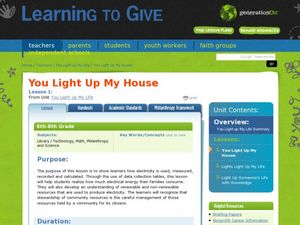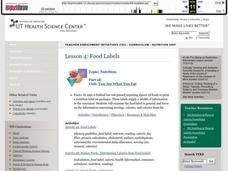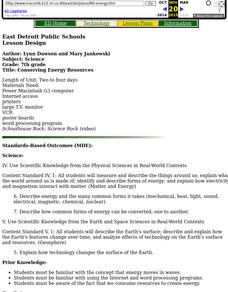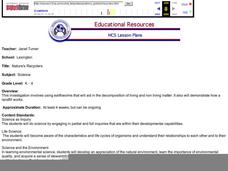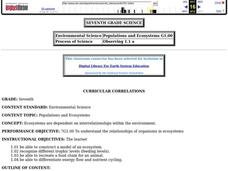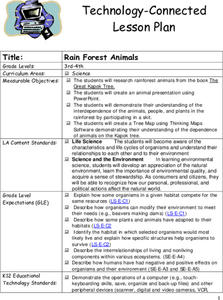Curated OER
Human Footprint
Students study facts about humans and how they are impacting the Earth. In this investigative lesson students help map peoples footprints over the Earth's surface and evaluate these factors.
Curated OER
Stamp It!
Students explore environmental issues through art. In this stamp instructional activity, students use preconsumer waste paper and colored pencils to create rubber stamp designs. This is an environmentally safe instructional activity.
Curated OER
You Light Up My House
Students explore renewable and nonrenewable resources. In this electricity lesson, students consider way to reduce the energy that they use as they chart and analyze their own electricity usage.
Curated OER
Clean Air: Our Health Matters
Middle schoolers learn about the human respiratory system. In this pollution lesson, students identify the parts of the respiratory system and what happens to them when they breathe in polluted air. Middle schoolers learn about the...
Curated OER
The True "Cost of Cool!"
Eighth graders study hidden environmental costs in things we buy. In this consumerism lesson students watch a video about consumerism and analyze advertisements in teen magazines.
Curated OER
You Are What You Eat
Learners examine food labels and study serving size and calories. In this healthy eating lesson students complete several activities to understand food labels.
Curated OER
Basic Tree and Forest Measurements
Young scholars examine how trees are measured and the different methods used. In this density lesson plan young scholars divide into groups and practice the different methods.
Curated OER
Potato Chips Fragility
Students investigate why some potato chips crumple faster than others. In this physics lessons, students relate the cooking time to potato's fragility. They write a lab report about their findings.
Curated OER
High Tech Food
Learners view videos, read, and fill in charts about agriculture production. For this agriculture lesson plan, students complete these agriculture activities and explore careers in agriculture.
Curated OER
Conserving Energy Resources
Seventh graders research on energy conversion. After they have researched several types of energy resources, teams of two to four create posters which depict how these resources can be conserved.
Curated OER
Nature's Recyclers
Learners create environments to demonstrate how earthworms interact with their surroundings.
Curated OER
Cranes, Crosswalks, and Big Gulps
Students watch a video and answer questions based on wildlife jobs. In this wildlife lesson plan, students learn that biologists don't just play with animals but that there is a lot of study involved.
Curated OER
Will Biotech Crops Solve World Problems?
Pupils read an online article to examine what biotechnology and agricultural biotechnology are. They answer questions and complete worksheets based on the article's information.
Curated OER
Populations and Ecosystems
Seventh graders create a model of an ecosystem and label it to show structure and function. They research the food web of an aquatic animal and also trace energy flow from the primary producer up the food chain.
Curated OER
Ecology and the Conservation of Natural Resources Lesson 2
Students compare and contrast abiotic and biotic factors. They discuss how these factors effect ecosystems. They answer questions to complete the lesson.
Curated OER
Earthquake!
Learners gain an understanding of earthquakes. They examine vocabulary associated with earthquakes, how earthquakes happen, and preventive measures taken to diminish damage or harm in the event that an earthquake should happen.
Curated OER
My Habitat Address
Sixth graders draw a habitat and write about what they would need to survive in the habitat. They define the input of items such as materials, energy, and information, and what goes out of the habitat. They play a "Habitat Address" game,...
Curated OER
Rain Forest Animals
Pupils research rainforest animals from the book The Great Kapok Tree. They create an animal presentation using PowerPoint. Pupils demonstrate their comprehension of the interdependence of the animals, people, and plants in the...
Curated OER
The Lesson: Cloning
Students explore the concept of cloning. In this cloning lesson, students research reproduction, cloning, and ethic issues. Students discuss their findings and write stories about extinct animals that are brought back to life.
Curated OER
Edible Wild Plants
Students explore the benefits of recognizing edible wild plants. In this wild plant lesson, students collect, make ready and eat edible plants. Students answer questions about the plants.
Curated OER
Carnivorous Plants
Young scholars examine how carnivorous plants get their nutrients from animals. In this food web lesson students examine how the plants attract their prey and are given many onilne sources to research.
Curated OER
Give a Hoot - Don't Pollute at Black Bayou Lake
Fourth graders visit Black Bayou Lake refuge to observe the effects of land and water pollution. They photograph examples of pollution. They list the effects of land and water pollution. They write a persuasive letter to convince others...
Curated OER
Forest Food Web
Students explore the elements of a forest ecosystem. They examine the elements needed to form a forest food web. Students construct and describe food webs that include nonliving elements of the ecosystem.
Curated OER
Heat and Light Come From Various Sources
First graders study heat and light and how they come from various sources. They list sources of heat and light and identify the different energy sources as heat, light, or both heat and light.
Other popular searches
- Family and Consumer Sciences
- Family Consumer Science
- Consumer Science Foods
- Consumer Science Manners
- Health and Consumer Science
- Consumer Science Fibers
- Consumer Science Fibres
- Fm & Consumer Science
- Family & Consumer Sciences
- Consumer Science Fib Res
- Consumer Science Careers
- Food and Consumer Sciences




